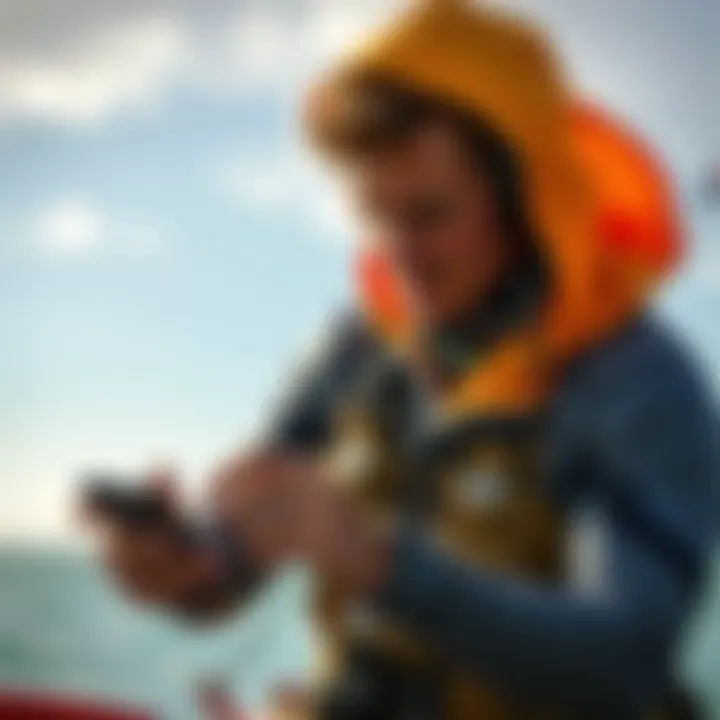Mastering Wind Forecasts for Kitesurfing Enthusiasts


Intro
Kitesurfing is more than just an exhilarating sport; it’s a dance with the wind. Understanding how to interpret wind forecasts is crucial for both novice and experienced kiteboarders, as it can significantly impact safety and performance on the water. From the subtle shifts in local wind patterns to the intricacies of various weather systems, grasping these elements is essential for a fun and secure kitesurfing experience.
In this guide, we will unravel the world of wind forecasting, laying out the key aspects every kitesurfing enthusiast should be aware of. You’ll find detailed insights on the various factors influencing wind patterns, learning methods for assessing wind conditions, and effective techniques for interpreting forecasts. The aim is to arm you with the knowledge needed to enhance your kiteboarding adventures.
Gear and Equipment
As you prepare to hit the waves, having the right gear can be just as vital as understanding wind conditions. The correct equipment not only enhances performance but also ensures safety on the water.
Essential Kiteboarding Gear for Beginners
Kitesurfing begins with the basics; even the most seasoned veterans started somewhere. When choosing initial gear, focus on quality and fit. Here’s what you should consider:
- Kite: Opt for a stable, easy-to-control model that suits your weight and skill level. Brands like Cabrihna and Slingshot have notable options for beginners.
- Board: A twin-tip board is ideal for newcomers, allowing you to ride in both directions. Look for one that offers sufficient buoyancy and stability.
- Harness: A comfortable harness will make extended sessions more enjoyable. You can choose between seat and waist harness options based on your preference.
- Safety Gear: Don’t skimp on safety equipment. A helmet and impact vest are vital, protecting you from potential mishaps.
Advanced Equipment for Experienced Riders
Once you’ve got the basics down, consider upgrading your gear to hone your skills:
- Foil Kites: These kites are designed to be more efficient and can provide great fun in lighter winds.
- Strapless Boards: For those looking to progress into wave riding or freestyle, strapless boards offer a more dynamic ride.
- Adjusted Harness: Custom or specialized harnesses can enhance your connection to the kite, allowing for more freedom of movement.
Investing in high-quality equipment tailored to your skill level can drastically improve your performance and safety in varying wind conditions.
Techniques and Tips
Knowledge is power in kitesurfing, but applying that knowledge effectively can make the difference between a solid session and a frustrating day.
Safety Practices for Kiteboarding
Understanding and implementing safety measures is paramount:
- Always check your gear before heading out. A well-maintained kite is less likely to fail.
- Communicate with other kiteboarders. A simple wave or nod can make your intentions clear.
- Familiarize yourself with the local conditions, including potential hazards like rocks or strong currents.
Training Techniques to Improve Your Skills
Improving your kitesurfing skills requires dedication and the right approach:
- Regular Practice: Like any sport, regular practice is essential. Set specific goals for each session and review your progress.
- Study: Watch tutorials or join courses tailored to your skill level. Learning from experienced instructors can provide invaluable insights.
- Wind Conditions: Start in lighter winds to build confidence before tackling stronger gusts.
Ultimately, knowing how to assess the wind and align your gear and skills can lead to a more fulfilling kitesurfing journey. For more in-depth strategies and community insights, platforms like Reddit and Facebook can provide support and knowledge from fellow riders.
"Wind is to kitesurfing what water is to fish; it's fundamental to your success."
Understanding and navigating the winds will elevate your kitesurfing experience, providing not only thrill but also safety.
The Importance of Wind in Kitesurfing
Wind is the lifeblood of kitesurfing. Without it, kitesurfers would be stranded on the beach, staring wistfully at the water. Understanding wind’s role is not just about ensuring a fun day on the waves; it’s about safety, performance, and making the most of every session.
How Wind Affects Kitesurfing Performance
Wind directly dictates the performance of a kitesurfer in numerous ways. The power available from the kite is proportionate to the wind speed; higher wind speeds translate to more power, which can either enhance exhilarating jumps or lead to loss of control for less experienced riders. A rider's weight and skill level greatly influence how wind affects their performance and ability to harness that power effectively.
- Beginners might find high winds daunting. A kite pulls significantly harder, and mastering control becomes tougher.
- Intermediate and advanced practitioners, however, often look for those stronger winds to perform tricks and stunts.
Moreover, wind stability plays a crucial part here. Sporadic gusts can create turbulence, making it difficult to maintain a steady course and putting unnecessary strain on both the rider and the equipment. Therefore, evaluating wind patterns thoroughly can make a world of difference, enabling surfers to know when and where to head out.
The Role of Wind Direction
Wind direction is just as vital as wind speed. It determines not only the effectiveness of a kite’s lift but also the rider's trajectory and speed across the water. A few critical points to note about wind direction include:
- Onshore Winds: These winds blow from the land to the sea. While they might seem inviting, they can sometimes be tricky for beginners as they tend to push the rider towards the shore, increasing the risk of collisions.
- Offshore Winds: Coming from the water out to the land, these winds can be ideal for experienced kitesurfers. They allow for longer rides but can be dangerous due to the risk of being blown away from the beach, particularly if something goes wrong.
- Sideshore Winds: Wind blowing parallel to the shoreline is often considered the best scenario. It provides a stable pull while allowing riders to maneuver freely.
Understanding wind direction empowers kitesurfers to make informed decisions about where to set up and launch, ultimately enhancing the safety and enjoyment of their time on the water.
"The wind is invisible, but it significantly shapes the experience of kitesurfing, determining both the thrill and the safety of each ride."
Key Wind Terms Every Kitesurfer Should Know
Kitesurfing is a thrilling sport that requires a firm understanding of various wind terms to navigate the elements successfully. For both seasoned riders and those new to the sport, grasping these terms equips you with the knowledge to make informed decisions about when and where to kite. In this section, we’ll break down some key terminology that can significantly enhance your kitesurfing experience.
Understanding Wind Speed Measurements


Wind speed is a critical factor in kitesurfing, impacting everything from your gear choices to the style of riding you can perform. Commonly, wind is measured in knots, where one knot equals about 1.15 miles per hour. Different kites require specific wind ranges to operate efficiently; knowing how to interpret these numbers is essential.
When checking wind speed, look for terms such as:
- Light Wind: Usually under 12 knots. It’s like trying to start a fire with wet matches; you might get some action, but it's tough to stay airborne.
- Moderate Wind: Between 12-20 knots, this breeze is more reliable and allows for solid performance without being overwhelming.
- Strong Wind: Anything over 20 knots can present a powerful force that novice kitesurfers should approach with caution. Strong winds require better technique and control.
Understanding these measurements not only helps in selecting the right kite but also prepares you for how the conditions might feel while out on the water.
Different Types of Wind Patterns
Wind doesn’t just come from nowhere; it’s shaped by various dynamics including geography, temperature, and pressure systems. Familiarizing yourself with wind patterns can be the difference between a smooth session and a rough ride.
Here are a few key patterns to note:
- Thermal Winds: These winds occur due to localized heating from the sun. As the land heats up during the day, the warm air rises, pulling in cooler air from the ocean or nearby water bodies. This phenomenon can create reliable winds, especially in coastal areas, making it the ideal time for kitesurfing.
- Prevailing Winds: These winds occur in a consistent direction over a period of time. Often, regions have a particular prevailing wind that can guide your choice of spots for kitesurfing. Understanding which way these winds blow can lead you to the best locations year-round.
- Bora and Mistral Winds: These specific types of winds are known for their strength and can suddenly change conditions, thus requiring you to be adaptable.
Being aware of local wind patterns can not only make your rides more enjoyable but also allow you to anticipate changes that may impact your safety.
"Knowing the wind is like understanding the tide; both can make or break your kitesurfing adventure."
Incorporating knowledge of wind speed measurements and types of wind patterns into your kitesurfing practice can significantly enhance your performance and overall experience. By continually learning and adapting, you’ll set yourself up for successful sessions on the water.
Factors Influencing Wind Conditions
Wind is the lifeblood of kitesurfing—without it, the sails don't catch, and the rides stay on land. Understanding what influences wind conditions is not just beneficial; it’s essential for anyone who desires to enjoy this thrilling sport safely and effectively. The interplay of several factors can create diverse wind experiences, so we’ll dive into the elements that shape wind behavior, helping kitesurfers make informed decisions.
Geographical Features
When considering wind conditions for kitesurfing, geographical features like coastlines, mountains, and valleys come into play. For example, coastal areas can produce strong, steady winds due to the temperature differences between land and sea. During the hotter days, land heats up more quickly than water, allowing air to rise and creating a vacuum that draws cooler, denser air from the ocean. This phenomenon enhances wind flow, resulting in delightful kitesurfing conditions.
In contrast, mountains can hinder winds by creating turbulence. As winds encounter elevations, they might swirl around, produce gusts, or even create wind shadows. These variations can lead to unpredictability, especially if the kitesurfer is not familiar with the local terrain. Moreover, valleys may act as wind tunnels, intensifying wind speed under the right conditions, making it critical for kitesurfers to understand the local landscape and how it may affect wind flows.
Weather Systems and Fronts
The nature of wind patterns is further influenced by weather systems and fronts. For instance, when a high-pressure system moves into an area, it often brings stable and predictable winds. This consistency can be a kitesurfer's dream, as they can plan their sessions around these known conditions. Conversely, low-pressure systems can introduce chaotic and unpredictable winds, a potential recipe for disaster if not approached with caution.
A front, which is a boundary between two different air masses, often ushers in changes in wind speed and direction. Cumulatively, these shifts will determine whether the day will be a ride filled with effortless glides or harrowing twists. If a cold front sweeps in, be prepared for winds that might change on a dime—what starts as an exhilarating session can quickly turn challenging.
"In kitesurfing, knowledge of weather systems isn't just an advantage; it’s a necessity for safe, enjoyable experiences on the water."
Seasonal Variability
Wind conditions also exhibit significant seasonal variability. Depending on the region, different seasons can vastly alter weather patterns. For instance, summer might deliver warm, stable breezes ideal for long kitsurfing excursions, while winter can bring fierce storms with unpredictable gusts and shifts. Understanding how seasons affect wind dynamics can be the difference between a fabulously exhilarating ride or a regrettable outing.
In some regions, transitional seasons like spring and autumn play a unique role. They can offer the best of both worlds, with relatively mild conditions and moderate winds. It’s during these times that local kitesurfers often report heightened excitement, leveraging the changing tides to find optimal conditions.
By paying attention to these seasonal effects, kitesurfers can strategically plan their trips, ensuring they are at the right spot at the right time.
Overall, grasping the factors that influence wind conditions transforms the kitesurfing experience from mere chance to an art form. It aids in anticipating changes and unleashing the potential of each outing.
Wind Forecasting Tools for Kitesurfers
Wind forecasting tools are the lifeblood of a kitesurfer's planning strategy. Without consistent access to precise and timely wind information, even the most skilled rider can find themselves caught off guard, leading to subpar experiences or even dangerous situations on the open water. In this section, we will explore various tools that provide essential data, offering insight into each tool's strengths, limitations, and how they can enhance your kitesurfing adventures.
Online Forecasting Platforms
When it comes to accessing wind forecasts, online platforms stand out as reliable resources for many kitesurfers. Websites such as Windy.com and Windfinder.com offer detailed wind maps and forecasts, alongside satellite imagery to visualize conditions. These platforms often consolidate data from multiple sources, providing users with a comprehensive view of wind patterns.
- Advantages:
- Considerations:
- Access to real-time data
- Visual representation through maps and graphs
- User-friendly interfaces that simplify navigation
- Be wary of potential misinformation stemming from data interpretation.
- Always cross-check forecasts from multiple platforms to gain a balanced understanding of wind conditions.
"Using online platforms gives kitesurfers an edge in planning their sessions, but it’s vital to stay informed and aware of data reliability."
Mobile Applications
In our fast-paced world, mobile applications have emerged as personalized wind forecasting tools for kitesurfers on the go. Apps like Kitesurfing Weather and iKitesurf provide forecasts directly on your smartphone. What sets these tools apart is their straightforward accessibility—check the wind from your pocket before heading out.
- Perks of Mobile Apps:
- Keep in Mind:
- Real-Time Notifications: Receive alerts when the wind hits optimal levels while at home or on the road.
- Integrated Community Features: Some apps allow kitesurfers to share experiences, tips, and conditions in specific locales.
- Customization Options: Users can tailor notifications based on personal wind preference or favored conditions.
- Mobile apps demand regular updates for accurate information. If your phone goes uncharged, so does your data.
- Internet connectivity may limit functionality, particularly in remote areas.


Local Weather Stations
Local weather stations have long been a preferred method for monitoring wind conditions, providing community-specific reports. In contrast to broader online platforms, these stations collect data from a smaller area, delivering precise wind measurements that can sometimes go unnoticed by larger forecasting systems.
- Benefits:
- Challenges:
- Localized Data: Essential insights into microclimates that affect wind patterns in unique ways.
- Consistency: Many local stations operate with a strong understanding of area wind behavior, making their predictions reliable.
- Relying on a single station may lead to skewed data, especially when other nearby stations exist.
- Find and make a note of every local station near your kitesurfing playground, as not all regions are equally equipped.
Interpreting Wind Forecasts
Knowing how to interpret wind forecasts is essential for anyone looking to take to the water on a kite. It’s not just about checking the weather report; it involves understanding various elements that can make or break your kitesurfing experience. When a forecast indicates wind speed and direction, it’s an insightful glimpse into what’s likely to happen on your planned journey.
One major benefit of accurately interpreting these forecasts is safety. An ill-timed adventure during high winds or unexpected changes can lead to dangerous situations. Thus, grasping the nuances of forecasting tools can significantly enhance not only your enjoyment but also the security of your outings.
Consider this: if conditions shift while you’re on the water, having a good sense of what a forecast genuinely means helps you make swift decisions. This knowledge empowers you to avoid being caught in a bind, whether it’s opting for an early exit or diving into the thrilling waves you're ready for.
Moreover, interpreting forecasts isn't just about wind speed and direction. It also involves looking at additional factors such as gusts, turbulence, and even temperature changes. All these elements play a role in determining how you'll perform on the water. Let's dig deeper into the specifics of decoding forecast charts and identifying reliable sources to sharpen your understanding further.
Decoding Forecast Charts
Forecast charts are visual representations of expected wind conditions and other atmospheric data. They can seem daunting at first glance, especially with all those lines and numbers, but understanding them is quite straightforward once you get the hang of it. These charts often depict wind speeds using specific color codes, with different colors indicating varying intensities. For instance, a bright red zone may represent winds over 25 knots, while shades of blue signal calmer energies.
To effectively decode these charts, it’s essential to focus on the following:
- Wind Speed: Pay attention to the numerical values associated with the colors. Knowing what winds feel like at specific speeds can inform your choice of gear and techniques.
- Direction Arrows: Notice the arrows that show where the wind is coming from. This information is crucial because even a small change in direction can lead to differing results on the water.
- Gust Indicators: Some charts will include data on gusts – those sudden bursts of wind that can catch you off guard. This data is not always present, but when it is, it can help you gauge the best times to ride.
To put it simply, feeling comfortable with these charts can greatly enhance your ability to make informed decisions out there in the waves. Once you can interpret them accurately, your confidence on the water will soar.
Recognizing Reliable Sources
Not all forecasts are created equal. In today’s world, there's a plethora of information available, but sifting through it to find what’s reliable is key to making informed decisions. Becoming adept at recognizing trustworthy sources for your wind forecasts can save you both time and grief.
When evaluating sources, keep these factors in mind:
- Established Meteorological Services: Websites associated with national agencies, like NOAA in the United States or similar institutions in other countries, usually provide the most reliable data.
- Specialized Kitesurfing Applications: Apps tailored for kitesurfers often integrate forecasts with user-generated reports, adding a practical angle to weather predictions. Look for user reviews highlighting the app’s accuracy.
- Community Feedback: Social media platforms and kitesurfing forums can be invaluable. Experienced kitesurfers often share insights about conditions in real-time, allowing you to gauge what’s happening on the ground.
Remember, combining information from multiple reliable sources can provide a clearer overall picture and enhance your prep before hitting the waves. The key is to not blindly trust one source; a failure to cross-reference might leave you paddling back in questionable conditions.
Always trust your gut, often your instincts are just as valuable as any forecast you can find.
By honing your skills in interpreting wind forecasts, you’ll not only ensure greater safety but also enrich your overall kitesurfing experience. With practice, understanding can grow from simply checking weather apps to becoming an informed decision-maker on the water.
Common Forecasting Misinterpretations
In the world of kitesurfing, the ability to accurately interpret wind forecasts plays a crucial role in ensuring a safe and enjoyable experience on the water. However, even the most seasoned kiters can fall prey to misinterpretations that can lead to oversights or, worse, unsafe conditions. This section addresses common pitfalls that can arise from misreading forecasts. Understanding these misunderstandings not only enhances one’s kitesurfing experience but also highlights the importance of an analytical approach to wind conditions.
Overestimating Optimal Conditions
One of the most frequent errors made by kitesurfers is overestimating what might be deemed as optimal wind conditions. This could stem from enthusiastic beginner riders who are eager to hit the waves or even seasoned kiteboarders who misinterpret data from forecasting tools.
Often, forecasts may show a promising wind speed that tempts kitesurfers to rush to the beach. However, it’s vital to understand that a number forecast does not equate to guaranteed safety and performance. Factors like wind variability, gusts, and a sudden drop in speed can lead to an unexpected mishap.
Consider the situation where a forecast indicates 20 knots on average—a speed generally favorable for kitesurfing. However, if those conditions include gusty winds ranging from 15 to 30 knots, it can be quite misleading. Riding in such inconsistent winds puts you at greater risk of losing control. Hence, it’s essential to look past the numbers and instead assess the quality and stability of the wind.
"Remember, the numbers won’t keep you safe; your judgment will."
Misjudging Wind Direction
Another critical pitfall involves misjudging wind direction. Kitesurfers often have a tendency to take forecasts at face value without considering how local geographical features can alter wind behavior. While the forecast may suggest a steady breeze coming from the east, real-world conditions can differ significantly due to terrain, buildings, or local weather patterns—these can create turbulence and wind shadows.
For instance, let’s say you are set to ride at a spot known for its westward winds. If you only glance at the forecast without acknowledging local landmarks like cliffs or tall structures, you might end up heading into confusing airflow, causing a frustrating—and potentially dangerous—session.
The direction from which the wind is blowing fundamentally affects your ability to glide effectively. A direct offshore wind, while enticing at first glance, may actually limit your safety due to the risks of being blown away from the shoreline. It’s always prudent to consider not just where the wind comes from in the forecast but also how it interacts with the local environment.
In essence, understanding these forecasting misinterpretations empowers kitesurfers to approach their craft with a more informed lens. The ability to synthesize wind data and local conditions leads to more effective decision-making, which is key to a successful kitesurfing adventure.
While wind data can be valuable, the ultimate takeaway is that kitesurfers should remain vigilant, continually reassessing conditions, and never underestimate the complexity of wind behavior.
Best Practices for Kitesurfing Based on Wind Forecasts
As any seasoned kitesurfer will tell you, understanding wind forecasts is not just about checking the conditions before you hit the waves; it’s about making informed decisions that enhance your entire kitesurfing experience. The right knowledge leads to optimal performance, reduces potential mishaps, and increases your overall enjoyment on the water. Here, we delve into two pivotal components that every kitesurfer should consider when interpreting wind forecasts: adapting to changing conditions and choosing gear accordingly.
Adapting to Changing Conditions


The wind is a dynamic force, subject to constant shifts influenced by various factors. Therefore, adaptability is essential for anyone serious about kitesurfing. You might head out with blue skies overhead, but that doesn't guarantee a pleasant session. One moment the wind might be blowing at a delightful 15 knots, and before you know it, that number could plummet or even spike, turning your ride from fun to frustration.
To stay ahead of the game, it’s crucial to:
- Monitor Real-Time Updates: Use apps like Windy or Windfinder that provide real-time data for local wind conditions. These tools often come packed with live wind alerts, allowing you to make on-the-fly decisions.
- Keep an Eye on the Sky: Changes in cloud cover or the appearance of cumulous clouds can signal shifts in wind strength. A sudden darkness may suggest a gust front is on its way; stay sharp and be prepared.
- Watch Other Kitesurfers: Observe the behavior of your fellow kitesurfers. If they’re packing up or retreating from the water, it may be time for you to do the same.
Adapting isn’t just about the wind; it also relates to your mindset. Stressing about missed opportunities can lead to poor decision-making. Recognize when conditions aren’t favorable and be willing to return another day.
Choosing Gear Accordingly
Selecting the right gear based on the wind forecast is a game-changer for kitesurfers. Just as the wind varies, so too does your gear's suitability in different conditions. Using the proper equipment can significantly enhance performance and safety. Here are foundational considerations when gearing up:
- Kite Size: A common misstep is using the same kite regardless of conditions. High winds necessitate smaller kites, while lighter winds favor larger options. Make a note of your usual wind conditions and have a reliable kite quiver for varying situations.
- Board Selection: Different boards perform better under specific wind conditions. For example, a twintip board is great for average winds, but in lighter conditions, you might benefit from a directional board that catches the breeze more effectively.
- Harness Fit: Ensure that your harness fits well. A snug fit optimizes control and comfort; an ill-fitting harness may hinder performance, especially if winds become gusty and unpredictable.
"Choose your gear wisely, and the wind will be your best friend. Choose poorly, and it could turn into a foe."
Staying ahead in gear selection involves understanding your own limits alongside the conditions at hand. Moreover, continued learning about new equipment and techniques can elevate your kitesurfing experience immensely.
Incorporating these best practices based on wind forecasts can drastically impact your sessions. The wind is always in flux, but your ability to adapt and choose the right gear can lead to safer and more rewarding kitesurfing adventures.
Planning Kitesurfing Trips
Planning a kitesurfing trip isn't just about packing your gear and heading to the beach. It's a multi-layered endeavor that involves understanding wind forecasts, local conditions, and choosing the right spot that meets your kitesurfing needs. For kitesurfers, especially those who want to maximize their time on the water, good planning is crucial. This section aims to outline the importance of proper trip planning, emphasizing how it can enhance both enjoyment and safety.
Researching Popular Kitesurfing Spots
When considering a kitesurfing trip, selecting the right location is key. Not all spots are created equal, and region-specific factors can significantly impact your experience. Some areas are known for consistent winds and suitable wave conditions, while others may present unexpected challenges.
- Spot Reputation: Certain beaches have built a strong reputation among kitesurfers. Locations like Tarifa in Spain and the Hood River in Oregon are often cited due to their reliable winds and vibrant kitesurfing communities.
- Amenities and Accessibility: Once you've identified popular spots, consider aspects such as access to facilities for launching, windsurfing schools, and rental services. Being close to amenities can save critical time and enhance comfort while on your trip.
- Local Regulations: It's prudent to check for any local rules regarding kitesurfing. Some beaches have restrictions during certain times of the year or specific zones designated for kitesurfing.
- Community Insights: Engage with local kitesurfing clubs or online forums on platforms like Reddit. These avenues provide the inside scoop on prevailing conditions and hidden gems not mentioned in travel brochures.
Understanding Local Wind Conditions
Once you've picked your kitesurfing spot, understanding its local wind conditions becomes vital. Local variations can differ greatly from broader forecasts, meaning a day that appears perfect on paper might not be great when you arrive.
- Microclimates: Recognizing that geographical features create microclimates can aid in grasping local wind dynamics. For instance, coastal cliffs or urban areas can create turbulence that alters expected wind patterns.
- Visual Indicators: Learning to recognize visual signs like wind on the water or the behavior of flags and trees nearby can provide real-time information about wind conditions. Watching other kitesurfers can also help gauge the general state of the wind.
- Timing is Everything: Be aware that wind conditions often change throughout the day. Early mornings might have lighter winds, whereas afternoons can build to a more robust breeze. Checking historical data for specific times can help you predict the best time to hit the water.
- Detailed Forecast Tools: Leverage local weather services or specialized kitesurfing apps that take into account more than just average wind speed. Look for forecasts that include gust reports, wind direction shifts, and potential storms.
"Understanding local wind can be the difference between a thrilling ride and a day stuck on the beach."
In summary, planning kitesurfing trips demands careful consideration. From researching popular spots to grasping their local wind conditions, the planning phase lays the groundwork for every successful outing. The more informed you are, the better your kitesurfing experience will be.
Safety Considerations
Kitesurfing can be a thrilling sport, but it isn’t without its risks. When it comes to wind conditions, every kitesurfer, from beginners to the most experienced, must understand the potential hazards. Knowing how to assess these risks can significantly improve not only one’s performance but also personal safety and that of others on the water.
Assessing Risks from Wind Conditions
Understanding wind conditions is like reading a road map before starting a long journey. If you don’t have a clear understanding of the terrain ahead, you may end up in uncharted waters. Varied wind speeds can lead to abrupt changes in kitesurfing performance, and understanding these can mean the difference between an exhilarating ride or a dangerous situation.
There are various aspects to consider:
- Wind Speed Ranges: The strength of the wind is generally measured in knots. Underestimating or overestimating wind speed can lead to equipment failure or accidents. A gentle breeze might seem harmless, but sudden gusts can catch you off guard.
- Wind Patterns: Familiarize yourself with local wind behavior. Is the wind consistent, or does it shift direction often? Local geographic features like mountains or buildings can influence wind flow, creating unexpected turbulence.
- Weather Conditions: Check how weather changes can affect wind. Storms or fronts can quickly escalate wind strength, posing serious risks to even seasoned kitesurfers.
Remember: "Don't let a good day of kiting turn into a bad day. Assess the winds before the thrill."
Emergency Preparedness
No amount of experience can replace good preparation. It's essential to have a plan in place should conditions take a turn for the worse. Being prepared can mitigate risks, enabling you to ride safely.
Here are steps for effective emergency preparedness:
- Gear Check: Always double-check your equipment. Safety leashes, kites, lines, and harnesses should be conditionally sound before you even hit the water.
- Know the Exit Points: Familiarize yourself with safe exits and rescue procedures in the kiting area. In an emergency, knowing where to go or how to signal for help can save time and lives.
- Communicate: Always inform someone about your kiting plans—your location, expected duration, and who to contact in case you don’t return on time.
- Buddy System: When possible, kitesurf with a partner. This way, help is readily available in case of an emergency.
- First Aid Kit: Carry a compact first aid kit. Even small injuries can escalate quickly when the wind is howling.
By focusing on these elements of safety, kitesurfers can ensure not only their own safety but also create a more secure environment for everyone in the vicinity. Engaging with the sport responsibly elevates the experience and builds a culture of safety among all riders. For more detailed safety protocols, visit the U.S. Coast Guard website at uscg.gov.
Finale
In the context of kitesurfing, understanding wind forecasts cannot be overstated. It’s not just an element of preparation; it's the backbone of the sport itself. Foreknowledge of wind conditions influences everything from the choice of kites and boards to ensuring safety on the water. A reliable wind forecast enables kiteboarders to seize ideal conditions, thereby enhancing both performance and enjoyment.
The relationship between kitesurfers and wind patterns is intricate. Cyclones or high-pressure systems in the vicinity can shift expected wind dynamics in an instant. This guide has explored vital insights into these factors, such as the geographical influences and seasonal touchstones that can affect the wind. Knowing these nuances allows kitesurfers to navigate their adventures more effectively, avoiding potential pitfalls. Furthermore, having access to various wind forecasting tools empowers enthusiasts to make informed decisions, ensuring they spend more time riding the waves rather than second-guessing their choices.
Moreover, our discussion on common misinterpretations about wind forecasts serves as a caution for kitesurfers of all levels. By synthesizing the essentials from this guide, one is not just acquainted with information but armed with practical knowledge that can drastically improve one's experience in the sport.
Recap of Key Insights
- Proficiency in Forecast Interpretation: Comprehending wind forecasts is crucial for kitesurfing success. The ability to decode these predictions can keep you on the right track, whether you are a novice mastering your first ride or a veteran looking for the perfect conditions.
- Safety Awareness: An understanding of wind dynamics can prevent mishaps on the water. Assessing risk based on accurate forecasts can mean the difference between an exhilarating adventure and a hazardous situation.
- Gear Selection: The right gear tailored to specific wind conditions maximizes performance. Familiarity with forecasting tools ensures that you choose the proper kite and board, which contributes to a more fulfilling session.
Encouragement for Ongoing Learning
As with any sport, kitesurfing constantly evolves, and so do the dynamics of wind forecasting. Thus, continuous learning is paramount. The tools and methods discussed in this article are foundational, but delving deeper into meteorological resources or joining a community like reddit.com/r/kitesurfing can provide further insights. Furthermore, attending local kitesurfing workshops or engaging with instructors can enhance your grasp of wind conditions in your area.
The journey does not end with this guide. Stay curious and inquisitive; investigate the multitude of factors influencing wind and weather patterns beyond kitesurfing. This doesn’t just enhance your skills but connects you more profoundly with the environment you are riding in. Embrace the learning, and let it guide you through the exhilarating world of kitesurfing.



